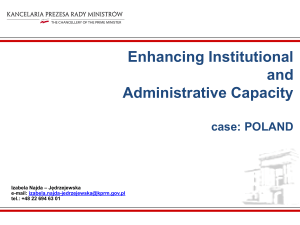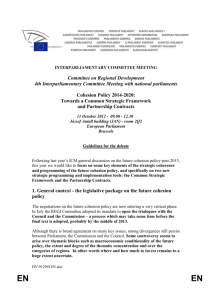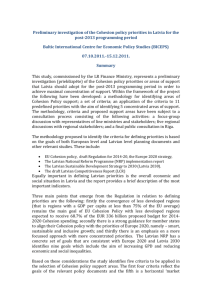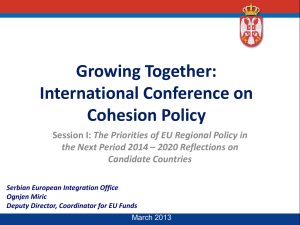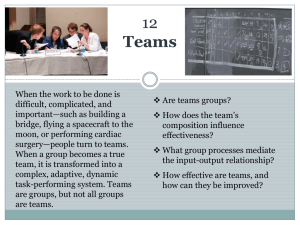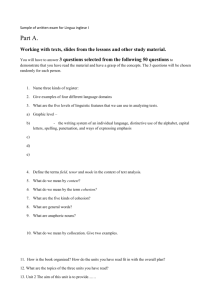Presentation Gabriella Fesus Future cohesion policy health 3
advertisement
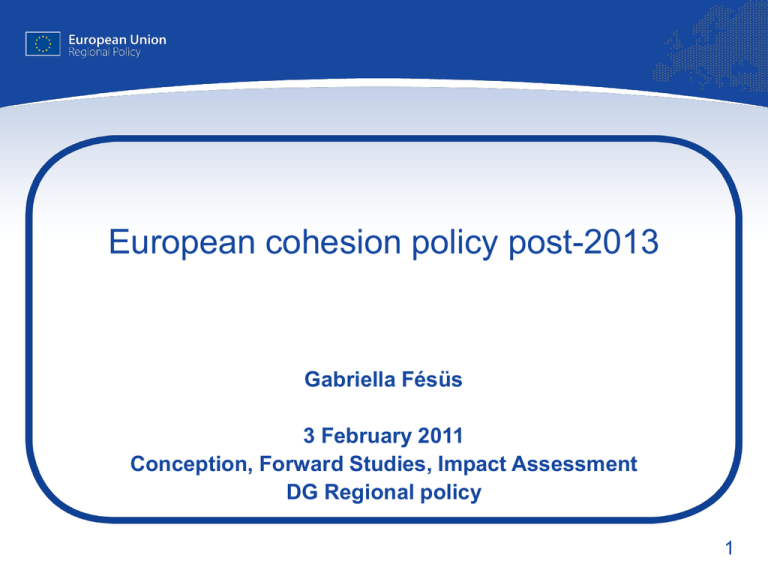
European cohesion policy post-2013 Gabriella Fésüs 3 February 2011 Conception, Forward Studies, Impact Assessment DG Regional policy 1 3 challenges for cohesion policy What is the European added value? • Geographical concentration • Sectoral vs. Territorial approach Effectiveness • Focus on results • Closer alignment with EU priorities such as Europe 2020 Efficiency • Assurance • Simplification 2 Political context Lisbon Treaty – Territorial cohesion – Co-decision Europe 2020 – Greater thematic approach, more focus, greater coherence – Structural reforms Reform of economic governance – Budgetary/fiscal contraints and risks 3 Europe 2020 3 thematic priorities: smart, sustainable, inclusive growth 5 EU headline targets – translated into national ones • Employment rate, R&D investment, climate change, renewable energy and energy efficiency, education and social inclusion/poverty 7 flagship initiatives – EU & national action • Innovation Union, Youth on the Move, Agenda for New Skills and Jobs, Platform against poverty, Industrial Policy, Resource efficient Europe, Digital Agenda Mobilising existing EU instruments: • • • • Single market External dimension Stability and Growth Pact (SGP) EU and national Budgets & new financing instruments 4 4 More value added: Geographical concentration • Concentration of resources on least developed regions • An instrument of redistribution or development? • Many regions face challenges of adjustment particularly in areas related to Europe 2020 • A fairer and smoother transition mechanism? 5 More Value Added: Thematic concentration • Alignment with Europe 2020 Objectives • Strategic framework to translate Europe 2020 into cohesion policy priorities • Focus on a limited number of priorities • Need for a national framework • Flexibility in determining policy mixes • Need to mobilise sub-national actors 6 Improving effectiveness • Better monitoring and evaluation • Clear and verifiable indicators • Conditionality and incentives – Macro-fiscal – Structural – Performance • Possibility of output based approach 7 Efficiency • A clearer chain of assurance – reinforcement of single audit approach • Efficient and simpler management and control systems • Greater differentiation • Financial flows/absorption • Harmonisation of eligibility rules • Combination of grants and loans 8 Key priorities for change • Align Cohesion Policy with priorities of Europe 2020 • Concentrate resources on a limited number of priorities • Introduce stronger incentives and conditionality • Move towards a result-oriented delivery system • Strengthen the strategic role of the Commission • Stronger emphasis on financial engineering (non-grant instruments in 2007-2013: EUR 10 billion) • Strengthen accountability and transparency 9 Approach to health in 2007-2013 • ERDF focuses on lagging regions to address deficiencies constituting barriers to development • Cross-border cooperation • Investments in health infrastructure, human resources, health promotion and disease prevention • E-health, innovation and research 10 Health investments 2007-2013 Between 2007 and 2013: •€5.1 billion (1.5% of the total of cohesion policy funding) has been earmarked to support health infrastructure 0% <1% 12% 23% 34% •€5 billion have been earmarked for e-services (including e-health) •€1 billion has been earmarked for active ageing, etc. 45% >5% Health infrastructure: Percentage of planned investments in health infrastructure in relation to the total amount of Structural Funds allocated to Member States in 2007-13. 11 Approach to health in post-2013 period • Alignment with the Europe 2020 strategy • Focus on main bottlenecks constraining growth in lagging Member States and regions • Foster structural change in health systems • Increase the quality of public expenditure • European Platform against Poverty 12 Final reflections • • • • • • Measurable and verifiable indicators Integrated cross-sectoral approaches Integrated urban development Community-based approaches Cross-border and transnational cooperation Conditionality linked to EU funds 13 Next steps • 9 November 2010: Fifth Cohesion Report • 11 November – 31 January 2011 – Public consultation on the 5th cohesion report • 31 January/1 February 2011: Cohesion Forum • Spring 2011: Future financial perspectives • Summer 2011: Legal proposals • 2012/13: Adoption of new legislative package • 2014: Entry into force 14 Thank you for your attention! gabriella.fesus@ec.europa.eu 15
